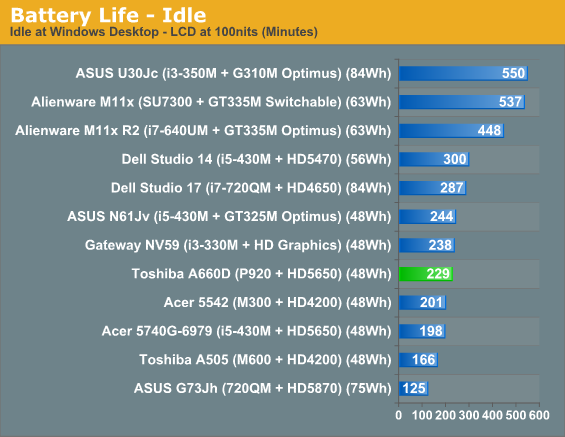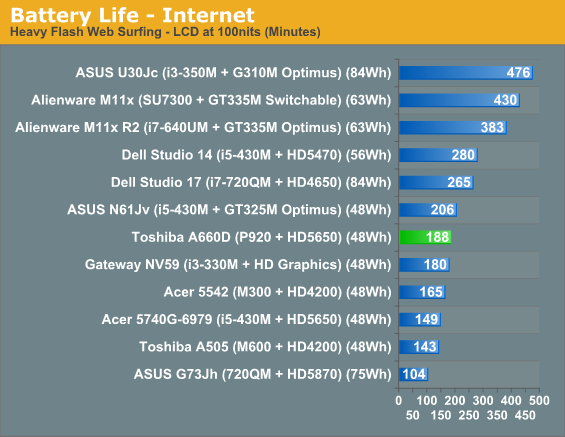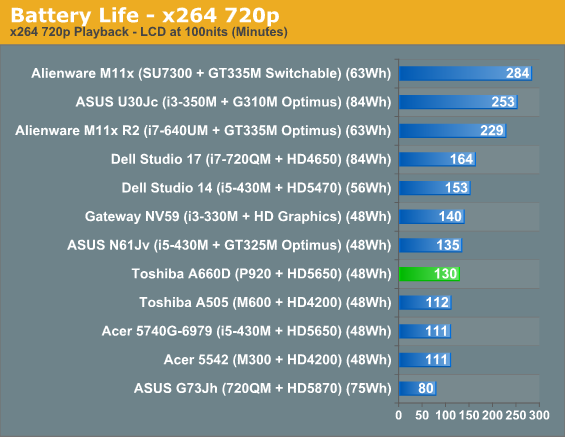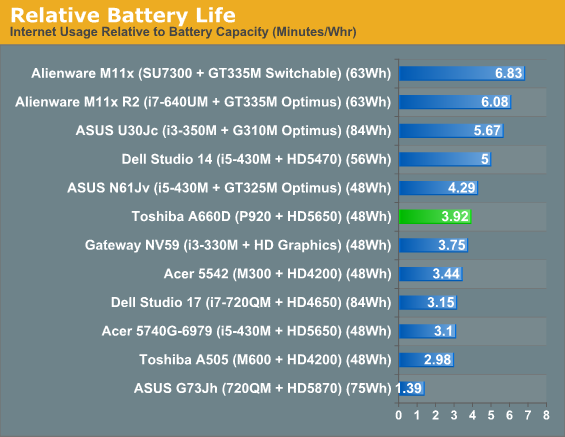Toshiba Satellite A660D-ST2G01: AMD's Quad-Core Phenom II P920 Joins the Mobile Party
by Jarred Walton on August 31, 2010 12:45 AM EST(Somewhat) Improved Battery Life
And now we come to the biggest change with Danube: better battery life. The Toshiba A660D isn't going to set any records, but considering it has a relatively small 48Wh battery and a quad-core processor it does well. We've optimized all of the laptops as much as possible to improve battery life, so keep that in mind—there's no AV or firewall software running, extraneous utilities are disabled, and we're using the Power Saver profile. We're also running off the integrated HD 4250 graphics for the battery results; if you choose to use the 5650, expect to lose at least 10-15% of the battery life. The LCD brightness is calibrated to ~100nits (58% in this case).




The A660D posts idle battery life just shy of four hours and Internet battery life of just over three hours. The x264 score is still pretty bad, lasting just long enough to get through a typical single movie, but again relative performance is important. Overall, battery life is up 16-38% over the Toshiba A505D, and 13-17% better than the Acer 5542 (M300). We're certainly curious as to how the dual-core P520 compares, given it has two fewer cores to power, but the P920 manages to beat the old M300 and M600 so that's already a clear win for the new Champlain parts.
What's not so rosy is the performance and battery life picture when we bring Intel results into the discussion. The quad-core Clarksfield cores deliver poor battery life, but considering i3-330M offers similar overall performance to the P920 in most tests (actually it's better performance overall) that's not really a good comparison. ASUS' N61Jv with Optimus and the Gateway NV59 are close to the A660D in terms of size and battery life. Intel still has a clear lead in overall performance, especially if you start including higher-end parts, but pricing and graphics performance generally favors AMD. At least it's no longer a 25% performance deficit with 25% worse battery life.
For the interested, the A660D consumes an average of around 15.3W during our Internet test, and just 12.6W at idle. The A505D consumes 17.4W idle and 20W in the Internet test, while the ASUS N61Jv uses 14W for Internet surfing and 11.8W at idle. Those results are on battery power using the test settings.










33 Comments
View All Comments
Dustin Sklavos - Tuesday, August 31, 2010 - link
Jarred, you are clearly a huge nerd. I'm obviously working with the right people.I'm pretty much drawing the same conclusions you are about this notebook. While I can't stand Toshiba's finishes, the real problem isn't Toshiba necessarily but that no one seems interested in producing a proper AMD notebook. The best you can do, I think, is custom-order one from HP (where at least you'll get an attractive build) or be prepared to make a lot of compromises.
It leads one to conclude that AMD's poor notebook market share can't solely be attributed to them...if the manufacturers don't make and market compelling machines using the available hardware, what can AMD really do?
Goty - Tuesday, August 31, 2010 - link
Sue Intel? Oh, wait, they did that already.Should be interesting to see the designs that come out with Bobcat.
fabarati - Tuesday, August 31, 2010 - link
Haha, Jared really is a big nerd.Too bad that Toshibia gimped the GPU in this one, and that the CPU still can't keep up. The AMD situtation is a bit of a catch 22: AMD has a (fairly rightly deserved) rumour of bad performance/batterylife, so people aren't willing to spend money on AMD laptops. The manufacturers see this, so they aren't willing to invest money in laptops people won't buy. That leaves us with cheap AMD laptops, or compromised expensive ones, that people won't buy.
fabarati - Tuesday, August 31, 2010 - link
"Computer, belay that order." Seriously, we need an edit button.I really miss the glory days of 16:10 as well. At least the manufacturers haven't gone further... yet. They might though. If they can get away with it, they'll probably go as far as 22:9, or at the very least 25:12 like in the Vaio P.
Personally, I'd pay extra for Intels performance, but that's me.
anactoraaron - Tuesday, August 31, 2010 - link
I think this is the thought process...Toshiba Assistant: "We made $XXXXXXX in profit for Intel notebooks last year and $XXX for AMD."
Toshiba Manager: "I guess we need to make better margins (lesser cheaper and charge more) on those AND or AMD or whatever you said that isn't making much money"
The result is us not getting a great well-rounded AMD notebook from any OEM (minus the custom build option mentioned). Shame really, and the 1366x768 on a 16 inch notebook is proof positive of that thought process. It isn't like if they build great AMD notebooks they wouldn't sell, it's just the ones they (the OEM's) make now aren't all that good - which is why they don't sell... and round and round we go...
Seriously, put in a better screen res and better 6 cell (or take a page from ASUS and put in an 8 cell) and sell it for $699 and watch it fly off the shelves.
SteelCity1981 - Tuesday, August 31, 2010 - link
The real question is why would you evenwant to consider a Phenom II X4 N920 in a laptop in which cost $950 dollars when you can get a Core i7 720QM laptop that cost roughly around the same price that would eat the Phenom II X4 N920 for lunch????? Nevermind the Core i5 series or even the Core i3 series for that matter that can rival the Phenom II X4 N920 in performance and has bettery battery life on avg for a lot less. The Phenom II X4 N920 would be much better suited in the $600 dollar price range where the Core i3's are than in the $900 dollar price range it's in now.Roland00 - Tuesday, August 31, 2010 - link
You are mixing your model numbers up.The P920 is a 1.6 ghz AMD Quad Core with a 25w TDP
The N930 is a 2.0 ghz AMD Quad Core with a 35w TDP
The N930 is 25% faster and is a much better cpu if you don't mind the extra tdp (which is not necessary the same as battery life). Pretty much the N930 is competitive with intel i line of chips but the P920 is not competitive.
SteelCity1981 - Tuesday, August 31, 2010 - link
Um not i'm not. the Toshiba Satellite A660D-ST2G01 cost $950 with the N920 cpu.Roland00 - Tuesday, August 31, 2010 - link
Here is the direct link of the model on toshiba websitehttp://laptops.toshiba.com/laptops/satellite/A660/...
Note the processor is a P920. Also read the first page of the review note Jared said the processor is the P920 at 1.6 Ghz. There is no such thing as a N920 processor from AMD, there is only a P920 and a N930 (which is 25% faster but has a 35w tdp instead of 25w)
The price is 949 which no one disagrees with. The speed sucks compared to the intel which no one disagrees with. The N930 processor speed is comparable to the Core I series of intel processors.
JarredWalton - Wednesday, September 1, 2010 - link
Given the A665D has an MSRP of $899 and sells at Newegg for $799, the real issue is the MSRP; I suspect the retail outlets will carry this notebook for a price closer to $850. It's still too much I think, but some will like the inclusion of ExpressCard/34 perhaps.The problem is that I figure there's only about $350 in the cost of a quad-core i7-720QM Intel chip (and that's being generous as OEMs probably get it for a lot less--wouldn't be surprised if they pay closer to half that much). But AMD's mobile parts aren't even remotely competitive with 720QM, so let's look at i5-520M. Intel pricing there is $225, and again OEM pricing has to be less than that.
Motherboards, chipsets, chassis, power, LCD, HDD, etc. are pretty much the same whether you get Intel or AMD. If you put together reasonable costs on all of those, a notebook like the A660 series (Intel or AMD models) costs something like $450-$550 just in materials without a processor. So the bottom line is you're looking at trying to build a laptop where the most money you can easily cut off by switching from Intel to AMD is maybe $100, and possibly not even that. AMD notebook bill of materials comes to perhaps $650 in this case, while the Intel notebook might come to $750 (depending on build order discounts).
If this notebook were priced at $699 as someone suggested above, it would be very close to losing money on each one produced. Though I suppose my math and estimates could be off, but R&D costs money too....